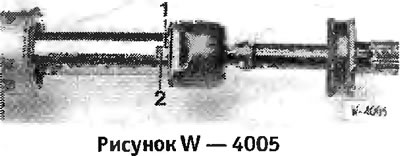Withdrawal
Remove wheel cover. Loosen the wheel bolts when the vehicle is on the ground.
Mark the position of the wheel disc on the hub with paint. Thanks to this, the balanced wheel is installed in its original place.
Raise the front of the car, remove the wheel.
(Drawing W 4003) Loosen the steering knuckle nut. Press out the steering knuckle joint with a suitable puller.

Variant without steering damper: Loosen the tie-down band and slide off the bellows.
Variant with steering damper: Fold back the lock.
Caution: Do not use a hammer as this could damage the steering gear.
Loosen the tie rod locknut with BMW tool 322100 or 322110 (on vehicles with steering damper). If no special tool is available, loosen the tie rod with a pipe wrench or 32 mm wrench.
Examination
Rotate the steering knuckle in different directions. If it moves easily or if there is play, replace the steering head joint.
Check integrity and seal (no traces of grease) cuffs. If the cuff is damaged, replace the steering tip joint.
Installation

Measure the old tie rod. Screw the tie rod end onto the tie rod while maintaining dimension -c-. Lock the steering tip.
If required, degrease the steering knuckle pivot and the seat on the knuckle arm.
Check and, if necessary, replace the bellows
Screw on the tie rod with a new lock.

The protrusion -1- on the lock fits into the cut-out -2- of the toothed rack.

Tighten tie rod to 70 Nm. In workshops, a 32 mm flat wrench is used for this, mounted on a torque wrench. Such a key can be made independently from a steel sheet 5 mm thick.
Bend the lock with a pipe wrench. Attention: In order to avoid damage to the toothed rack, never bend the lock with a hammer.
Put on the corrugated cover and secure it with a strap. Do not twist the corrugated cover.
Insert the tie rod into the steering linkage arm. Screw in a new self-locking nut with a tightening torque of 40 Nm.
Put the wheel on.
Lower the car.
Tighten wheel bolts crosswise to 110 Nm.
Check toe adjustment.
